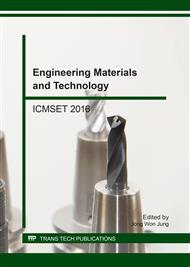p.209
p.214
p.220
p.225
p.231
p.236
p.242
p.248
p.256
Rheological Properties of Asbestos Waste Filler-Based Epoxy Composite Materials
Abstract:
Buildings and structures susceptible to aggressive environmental and industrial factors are often protected by composite materials. The latter most notably include polymer-based composites. The rheological properties of filled epoxy composites with fillers based on construction and chemical industries’ waste, as well as composites based on natural mineral material, have been researched and accessed. Optimal degrees of filling for such composites have been determined. Border values of filling have also been determined. Authors attempt to determine the dependencies of rheological properties upon the degree of filling and technological factors. The microstructure of epoxy composite materials has also been taken into consideration. The specific features of deformability processes in of epoxy composite materials have been predicted. The mathematical processing of test results has been carried out.
Info:
Periodical:
Pages:
231-235
Citation:
Online since:
June 2017
Authors:
Price:
Сopyright:
© 2017 Trans Tech Publications Ltd. All Rights Reserved
Share:
Citation:


